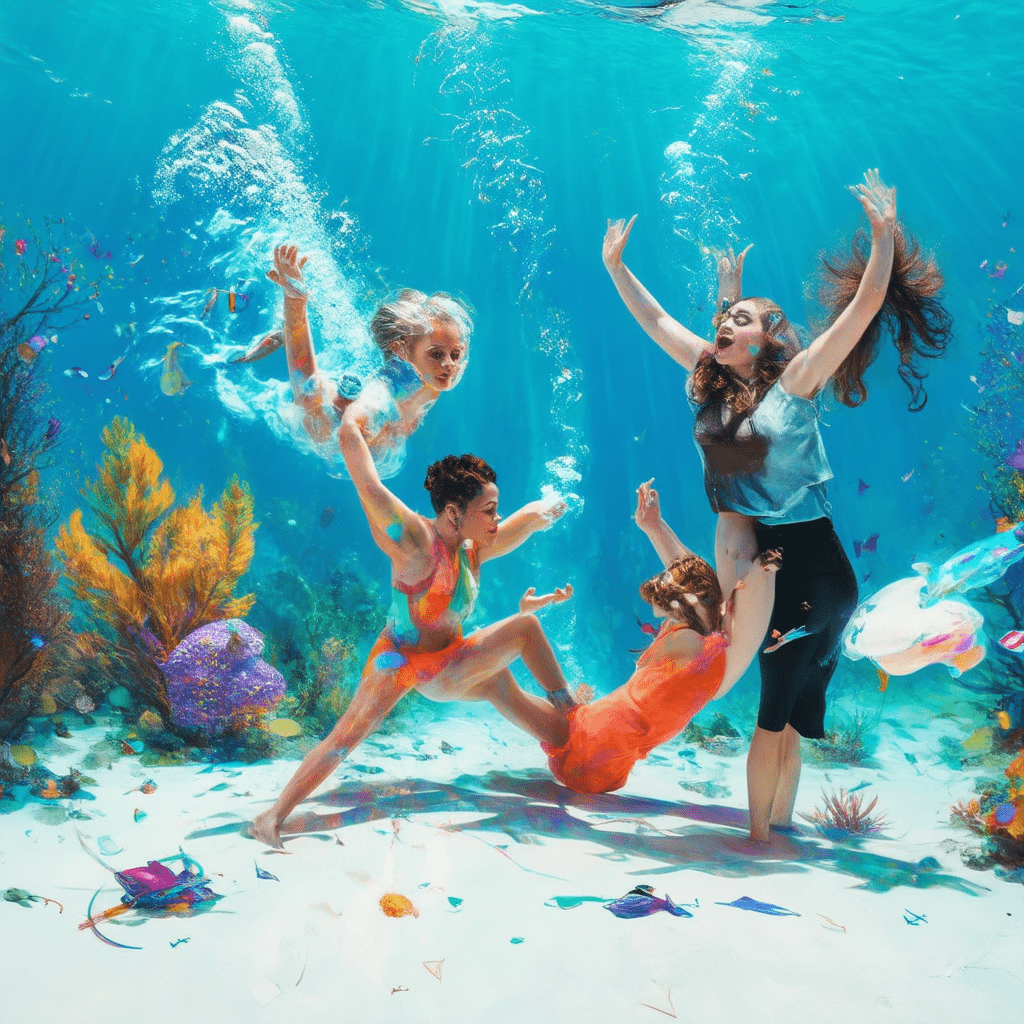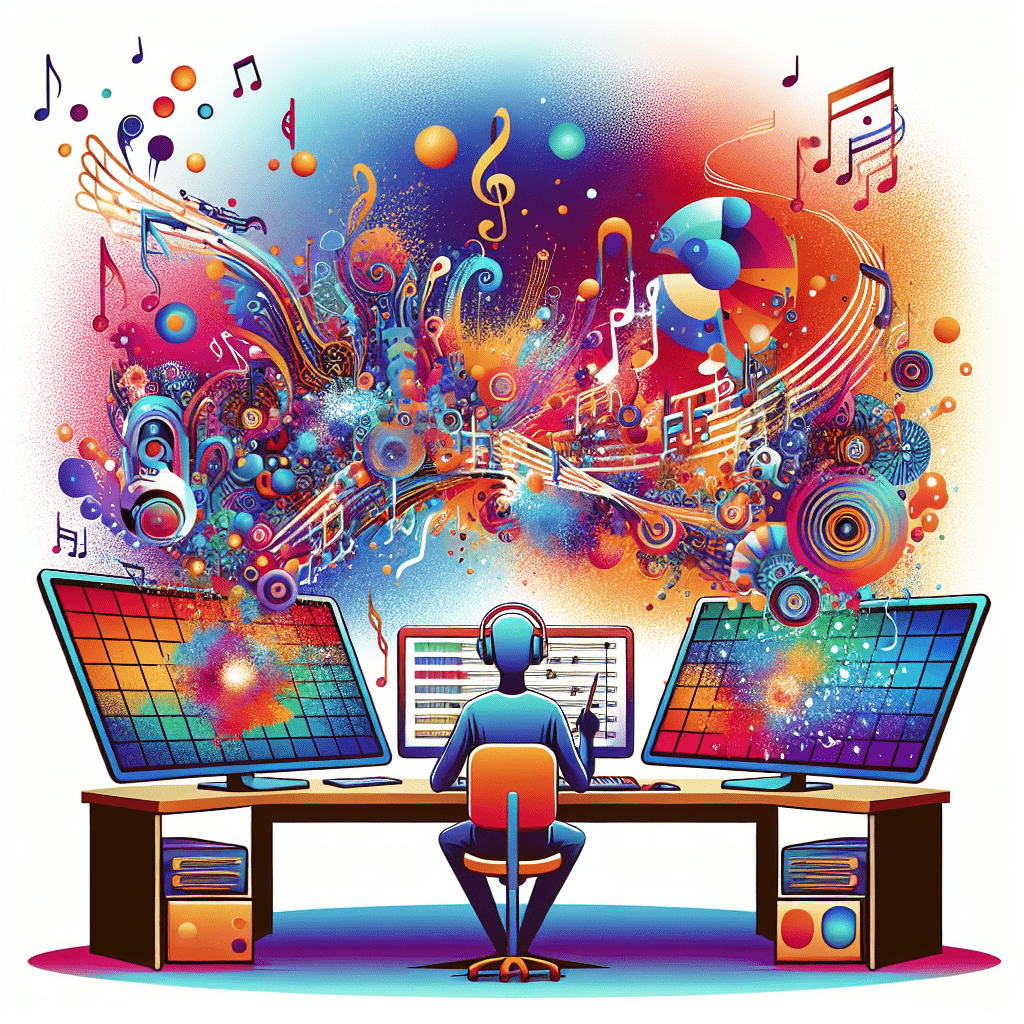Introduction: A Deep Dive into AI-Generated Art and Music
Table of Contents
Hey there, tech enthusiasts! AI-Generated Art and Music aren’t just buzzwords—they’re reshaping the creative landscape right before our eyes. Remember the early days, back in the late 20th century? That’s when computers first dipped their toes into generating simple art and music. It was more of a quirky experiment back then. But fast forward to today, and we see a world where AI isn’t just a participant in the art scene—it’s a major player. (Read our full guide on AI in Media and Entertainment.)
Think about it: with the explosion of sophisticated algorithms and the power of machine learning, AI now crafts intricate compositions and breathtaking visual pieces that can stand toe-to-toe with human-made creations. Take Google’s DeepDream, for instance. It turns ordinary images into surreal works of art, revealing layers of complexity that are both mind-bending and visually stunning. Or consider OpenAI’s MuseNet, which can compose symphonies in the style of Mozart or pop hits reminiscent of The Beatles.
In my experience, what’s particularly fascinating is how AI challenges our preconceptions about creativity. A common mistake I hear is the assumption that creativity is solely a human domain. Yet, here we are, witnessing AI produce art that evokes emotion, tells stories, and even sells for hefty sums at auctions. The key takeaway here is the blurring lines between human and machine creativity. This isn’t just about technology; it’s about redefining what it means to be creative in the modern age. As AI continues to evolve, we’re only scratching the surface of what’s possible, and that’s truly exciting.

Key Benefits and Advantages
AI’s impact on art and music isn’t just about innovation—it’s about transforming the very fabric of how we create and consume. Picture a world where AI can seamlessly blend genres, creating a symphony that marries the complexity of Beethoven with the pulsating beats of modern electronic dance music. This isn’t just a hypothetical; it’s already happening. For instance, OpenAI’s MuseNet can compose music in the styles of classical composers while integrating elements from contemporary genres, offering a fresh listening experience that defies traditional boundaries.
In the visual arts, AI is enabling artists to push the limits of their creativity. Imagine a digital canvas where impressionist brush strokes coexist with hyper-realistic digital imagery, creating a new form of visual storytelling. A well-known example is the AI-generated artwork “Edmond de Belamy,” which sold at auction for over $432,000, challenging the notion of authorship and value in art.
Moreover, AI is democratizing access to artistic tools. Platforms like Artbreeder allow users to create unique artworks by merging existing images, making high-level artistic creation accessible to those without formal training. This collaboration between human creativity and machine learning is breaking down barriers, enabling a broader spectrum of people to express themselves artistically.
AI doesn’t just augment creative processes; it invites new forms of collaboration. Musicians and visual artists are working alongside algorithms, using AI as a tool to explore uncharted territories. This partnership is not about replacing human creativity, but enhancing it, providing artists with a new palette of tools to experiment and innovate. The key takeaway here is that AI is not just a tool; it’s a catalyst for a new era of artistic exploration, where the only limits are the boundaries of imagination.
- Tailored Art and Music: Imagine opening an app that knows you so well, it crafts a piece of art or a song just for you, tapping into your unique tastes and moods. AI can analyze your listening habits, the colors you respond to, or even your favorite styles, creating a personalized masterpiece that reflects your personality. Spotify’s Discover Weekly gives us a taste of this, suggesting songs based on your listening history, but AI-driven art takes it further by potentially generating entirely new pieces that echo your preferences, offering a deeply personal creative experience.
- Education: For budding artists and musicians, AI serves as an invaluable tutor. Picture a digital mentor that not only corrects your mistakes but also suggests innovative ways to improve your technique in real-time. Whether it’s adjusting brush strokes in a digital painting app or suggesting harmonic variations in music composition software, AI can simplify the learning curve, making the arts more accessible. Adobe’s Sensei, for instance, offers tools that help users enhance their projects with ease, guiding novices through complex processes with intuitive suggestions.
- Entertainment: The entertainment landscape is being reshaped by AI, which crafts movie soundtracks and video game art with stunning precision. AI can analyze the emotional beats of a film, composing scores that heighten suspense or amplify joy at just the right moments. Similarly, in video games, AI-generated art and environments create immersive worlds that evolve based on player interactions, offering a fresh experience with each playthrough. Netflix’s AI-driven content recommendations are just the beginning; the future might see AI crafting entire storylines tailored to individual viewers.
- Live Performances: Imagine attending a concert where the visuals and music evolve based on the audience’s energy. AI can analyze crowd reactions, adjusting the tempo and visuals to match the mood, turning a passive show into an interactive spectacle. This technology can transform live performances into dynamic experiences, where every show is unique. Artists like Imogen Heap have experimented with AI to adapt their music live, creating an ever-changing auditory and visual feast.
- Interactive Installations: AI allows art installations to come alive, responding to the presence and emotions of the audience. These dynamic pieces react to viewers’ movements, offering a personalized experience for each spectator. For instance, a digital mural might change colors or shapes as people walk by, or an installation might play music that shifts based on the crowd’s mood. These responsive creations make art a participatory experience, pulling viewers into the creative process.
- Social Media Content: AI tools empower social media creators to produce tailored content that stands out in a crowded digital landscape. By analyzing engagement metrics, AI can suggest optimal posting times, content formats, and even generate personalized graphics or captions that resonate with specific audiences. Platforms like Instagram and TikTok are already leveraging AI to recommend content that keeps users engaged, but creators can use these tools to craft posts that speak directly to their followers, enhancing connection and engagement.
How It Works: A Practical Explanation
AI-generated art and music, at their core, are creative outputs crafted by algorithms. This field, often referred to as generative art, covers a broad spectrum that includes everything from intricate paintings to complex symphonies. The true wonder of this technology lies in its foundation: machine learning and neural networks. These advanced systems are trained on massive datasets, absorbing styles, and patterns to produce new, unique pieces.
Imagine an AI system examining thousands of works by Monet or Van Gogh, not just to replicate their strokes but to understand their essence. The result? Art that feels both familiar and entirely novel. In music, AI can analyze Beethoven’s symphonies, learning the nuances of his compositions, and create an entirely new orchestral piece that echoes his genius without being a mere imitation.
In my experience, one of the most striking examples is the work of AI artist Sougwen Chung, who collaborates with machines to produce hybrid artworks. Her approach isn’t about replacing human touch but enhancing it, blending human intuition with algorithmic precision.
From a practical standpoint, AI’s role in art and music challenges our traditional notions of creativity. What this means in the real world is a shift in how we value artistic expression. It’s not just about human versus machine; it’s about exploring new frontiers of creativity. Whether it’s an AI creating a hauntingly beautiful melody or a painting that evokes deep emotions, the key takeaway here is that AI is not confined to copying—it thrives on innovation.

Case Study: A Real-World Example
Imagine strolling through a gallery or tuning into a playlist, only to discover that the masterpieces before you weren’t crafted by human hands or voices, but by algorithms and machine learning models. This isn’t the plot of a sci-fi novel; it’s happening now, reshaping what we consider art and music. Let’s break it down with some real-world examples.
Take the portrait “Edmond de Belamy,” crafted by the French art collective Obvious using a Generative Adversarial Network (GAN). When it went under the hammer at Christie’s, it fetched an astounding $432,500. The sale sent ripples through the art world, challenging perceptions of authorship and originality. Was it the creators, human or machine, that imbued this piece with its value? This sale wasn’t just about the art itself; it was a statement about the evolving definition of creativity.
Switching gears to music, Taryn Southern’s album “I AM AI” exemplifies how AI tools are becoming collaborators rather than mere instruments. Using software like Amper Music, Southern produced tracks that blend human emotion with machine precision. It’s a fascinating collaboration, where the artist inputs her vision and the AI translates it into complex musical compositions. This process doesn’t replace the human touch; rather, it augments it, offering new ways to experiment and innovate.
These examples underscore a broader trend: AI is no longer just a tool; it’s becoming a partner in creative processes. While some may fear a future where machines overshadow human creativity, others see an opportunity. AI can handle repetitive tasks, allowing artists to focus on the more expressive aspects of their work. It’s about balance and collaboration, not competition. As AI continues to evolve, we might see an even richer tapestry of creative expression, where human and machine work in harmony to push the boundaries of what’s possible.
Conclusion: Key Takeaways
AI-generated art and music are like the new kid on the block, bringing fresh ideas that challenge our traditional views. They’re not about replacing the soul of human creativity but adding a new twist to it. Imagine a painter who uses AI to explore color combinations they hadn’t considered before, or a musician who collaborates with AI to create soundscapes that push the boundaries of what we know as music.
In my experience, AI can act like a muse. It doesn’t just replicate what’s already been done but opens doors to novel possibilities. For instance, Google’s DeepDream project revealed a unique way of interpreting images, transforming ordinary photos into psychedelic works of art. Similarly, OpenAI’s MuseNet can compose intricate music pieces, blending styles from classical to contemporary, showcasing how AI can understand and create complex musical structures.
There’s a palpable excitement in seeing how AI can complement our creative processes. Think of it like a jazz improv session where unexpected notes lead to a completely new melody. What this means in the real world is that artists and musicians are now equipped with tools that help them break free from conventional constraints.
Engaging with AI-generated content on social media can spark discussions that propel innovation. Sharing your experiences can help build communities where ideas flow freely. It’s like a modern-day salon where artists, technologists, and enthusiasts mingle, exchange ideas, and push the boundaries of what’s possible. The key takeaway here is that AI isn’t just about creating; it’s about co-creating and enriching the tapestry of human expression.

